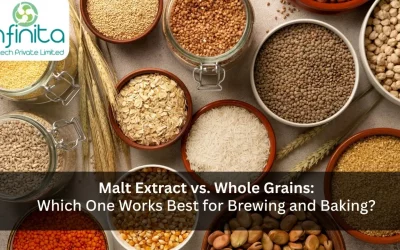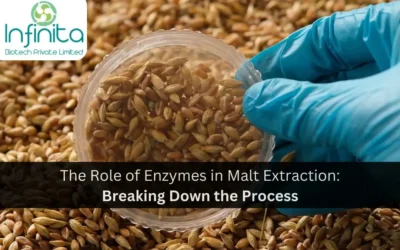Malt extraction is a crucial process in the brewing industry that relies on the strength of enzymes to convert starches in grains into fermentable sugars. By understanding the basics of malt extraction and the science behind it, brewers can optimize their techniques to achieve desired flavors and improve efficiency.
The Basics of Malt Extraction
What is Malt Extraction?
Malt extraction is the process of extracting fermentable sugars from malted grains, primarily barley, to produce the wort, which serves as the foundation for brewing beer. Malted grains undergo a carefully controlled germination process that activates enzymes within the grains, enabling the conversion of starches into fermentable sugars.
During the malting process, barley grains are soaked in water and allowed to germinate. This germination activates enzymes that break down the complex carbohydrates in the barley into simpler sugars, which can be fermented by yeast during the brewing process. The germinated grains are then dried in a kiln to halt the germination process and preserve the enzymes for later use in mashing.
The Role of Enzymes in Malt Extraction
Enzymes play a vital role in malt extraction by breaking down complex starches into simpler sugars. The key enzymes involved in this process are alpha-amylase and beta-amylase. Alpha-amylase breaks down starches randomly, producing a mixture of fermentable and unfermentable sugars, while beta-amylase selectively breaks down starches into fermentable sugars such as maltose.
These enzymes are activated during the mashing process, where the malted grains are mixed with hot water to create a mash. The enzymes then work to break down the starches in the grains into sugars, creating a sweet liquid known as wort. The wort is then separated from the spent grains and transferred to the next stage of the brewing process, where yeast is added to ferment the sugars and produce alcohol.
The Science Behind Malt Extraction
Enzymes and Their Functions
Enzymes are biocatalysts that speed up chemical reactions without being consumed in the process. In malt extraction, enzymes act as catalysts to convert starches into sugars. Through their specific functions, enzymes determine the types and quantities of sugars produced, influencing the flavor profile of the final beer product.
One of the key enzymes involved in malt extraction is amylase. There are two main types of amylase: alpha-amylase and beta-amylase. Alpha-amylase breaks down starch molecules into longer chains of sugars, while beta-amylase further breaks these chains into fermentable sugars like maltose. The balance between these enzymes during mashing plays a crucial role in determining the fermentability and sweetness of the wort.
The Process of Malt Extraction
The process of malt extraction involves several key steps. First, the malted grains are crushed to expose the starches inside. Then, the crushed grains, known as grist, are mixed with hot water in a process called mashing. During mashing, the enzymes in the malted grains come into contact with the starches, initiating the conversion process. The resulting liquid, known as the wort, is then separated from the solid grain particles.
After separation, the wort undergoes a process called lautering, where the liquid is gently rinsed from the grain bed to remove any remaining sugars. The wort is then transferred to the brew kettle, ready for the next stages of the brewing process.
Following lautering, the wort is brought to a boil in the brew kettle. Boiling serves multiple purposes in the brewing process, including sterilizing the wort to remove any unwanted microorganisms, extracting hop bitterness and flavors, and concentrating the wort through evaporation. This step also helps to coagulate proteins and break down complex sugars further, preparing the wort for fermentation.
The Strength of Enzymes in Malt Extraction
Factors Affecting Enzyme Strength
Several factors can affect the strength of enzymes in malt extraction. The quality and variety of malted grains used, the temperature and pH of the mashing process, and the duration of the enzymatic activity all play significant roles. Brewers must carefully consider these factors to optimize the extraction process and achieve desired results.
Furthermore, the water-to-grain ratio during mashing can also influence enzyme strength. A higher water content can dilute the enzymes, potentially reducing their effectiveness in breaking down starches into fermentable sugars. On the other hand, a lower water content may lead to a thicker mash, which could hinder enzyme mobility and substrate accessibility. Balancing the water-to-grain ratio is crucial in maximizing enzyme activity and ensuring efficient malt extraction.
How Enzyme Strength Impacts Malt Extraction
The strength of enzymes directly affects the efficiency and flavor profile of the malt extraction process. Insufficient enzyme activity can result in low sugar conversion rates and incomplete fermentation, leading to undesirable flavors and reduced alcohol content. Conversely, excessive enzyme activity can lead to over-fermentation and a thin, dry beer. Understanding and controlling enzyme strength is therefore vital to achieve the desired balance of flavors and characteristics in the final beer.
Moreover, the specific types of enzymes present in the malt also contribute to the overall enzyme strength. Enzymes like alpha-amylase and beta-amylase play distinct roles in breaking down starches into sugars during mashing. The ratio of these enzymes and their activity levels can significantly impact the final composition of the wort. Brewers often adjust the mashing conditions and enzyme additions based on the malt’s enzyme profile to tailor the extraction process to their desired beer style.
Optimizing Malt Extraction
Techniques for Enhancing Enzyme Strength
Brewers have various techniques at their disposal to enhance enzyme strength during malt extraction. Adjusting the pH and temperature during mashing can activate enzymes and optimize their activity. Utilizing multiple enzyme rests at different temperatures and extending the mashing time can also improve enzyme efficiency.
Another method that brewers often employ to enhance enzyme strength is the addition of exogenous enzymes. These enzymes can supplement the natural enzyme content in malt, providing a boost in enzymatic activity and aiding in the breakdown of complex carbohydrates during mashing. By carefully selecting and incorporating specific exogenous enzymes, brewers can tailor the mashing process to achieve desired levels of fermentability and extract yield.
The Future of Malt Extraction Technology
Advances in malt extraction technology continue to push the boundaries of efficiency and flavor control. Innovative techniques, such as enzymatic manipulation and novel germination processes, are being explored to enhance enzyme strength and create unique flavors in brewing.
One emerging technology in malt extraction is the use of precision enzymes that target specific substrates, allowing for more controlled and efficient saccharification. By utilizing these precision enzymes, brewers can achieve higher levels of sugar extraction from malt, leading to increased alcohol production and improved overall brewing efficiency. Additionally, advancements in germination technology, such as controlled sprouting conditions and tailored enzyme development, are enabling brewers to manipulate the enzymatic profile of malt to create custom flavor profiles and enhance brewing versatility.
The Impact of Malt Extraction on Brewing
Malt Extraction and Beer Flavor
Malt extraction is a significant factor in determining the flavor profile of beer. The types and quantities of sugars produced during extraction influence the alcohol content, sweetness, body, and overall character of the final product. By understanding enzyme strength and optimizing extraction techniques, brewers can craft beers with a wide range of flavors, from crisp and light to rich and malty.
Furthermore, malt extraction plays a crucial role in developing the aroma of beer. The Maillard reaction, a chemical reaction between amino acids and reducing sugars that occurs during malt extraction, produces a complex mixture of compounds that contribute to the beer’s aroma. Depending on the intensity of the Maillard reaction, brewers can achieve notes of toast, biscuit, caramel, or even coffee in their beers.
The Role of Malt Extraction in Brewing Industry
Malt extraction is the foundation of the brewing industry and the starting point for producing quality beers. Brewers rely on the control and manipulation of enzyme activity to create unique and consistent flavors that define their beer brands. Understanding the strength of enzymes in malt extraction is essential for brewers seeking to push the boundaries of brewing creativity and meet consumer demands.
Moreover, malt extraction not only influences the flavor and aroma of beer but also affects its appearance and mouthfeel. The proteins and polyphenols extracted during the mashing process can impact the beer’s clarity, foam stability, and body. Brewers carefully adjust their extraction techniques to achieve the desired balance of proteins and polyphenols, ensuring a visually appealing beer with a smooth mouthfeel.
With a deep understanding of malt extraction and the strength of enzymes, brewers can unlock the full potential of their ingredients and create outstanding beers that delight the palate of beer enthusiasts worldwide.







